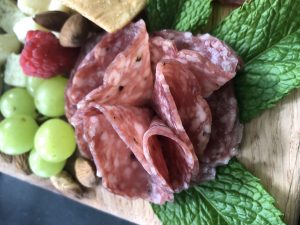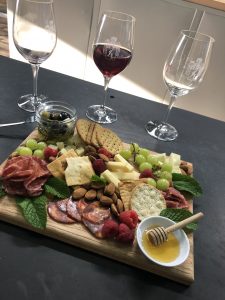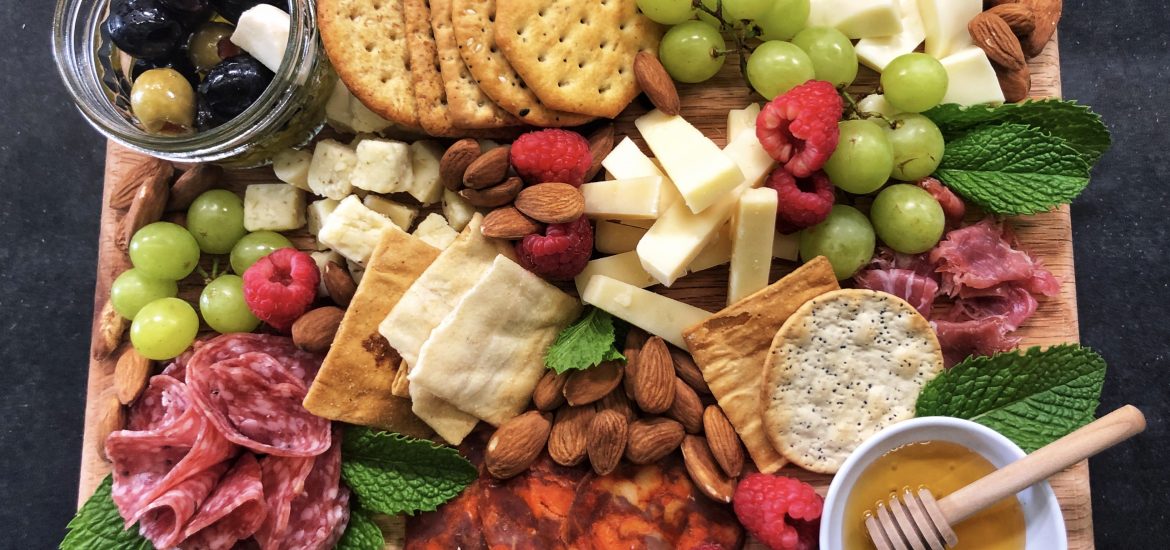Appetizers are the new dinner party.
Small plates, snacking, and shared meals are all the rage as restaurant-goers, and home diners are turning away from overwhelming portions and looking for something different. Enter the charcuterie board.
If you’re looking for a simple and elegant spread, ditch the traditional menu at your next gathering and instead construct a charcuterie board. You’ll impress your guests, plus with this easy make-ahead dish, you’ll be able to enjoy your gathering.
Charcuterie, the French culinary art of the production of meat, sausages, pate, and terrine, has been around for thousands of years.
“The word charcuterie translates to cooked meat or cured meat. It is not a charcuterie plate if you use lunch meat – so don’t,” says Sharon Puren, general manager of the winery & tasting room at Kiepersol, with a grin. “That’s the only rule. Otherwise, you can’t go wrong.”
While the name can be challenging to say, (it’s pronounced shar-kood-eree), the dish couldn’t be simpler to put together. No need to turn on the oven or stand over the stove, with just a few tips you’ll be able to construct the perfect board. So, let’s get started.
The four components to consider when building a charcuterie board are texture, flavor, color, and shape. Keep these components in mind when selecting products. It’s best to begin with the meats, as they will be the backbone of the board.
Plan on two ounces of meat per person.
Two to three meats for hor’s d’ oeuvres and five to six meats if the board will act as the main course. Don’t be afraid to ask for samples when deciding what to choose. Butchers are usually happy to assist, and they can be an excellent resource.
Hard salami, prosciutto, smoked ham, dry-cured chorizo, Genoa salami, capicola, sausages, pates, and terrines are all excellent choices. Ask for the muscle cuts, such as salamis and prosciutto, to be thinly sliced. Pate adds a soft and delicate texture while sausages add a hearty touch.
Next, select the cheeses.
“You’ll need at least three types; soft cheese, hard cheese, and a bold, stinky cheese,” says Puren. “Soft cheeses such as feta, brie, and camembert are bright and tangy, where your gorgonzolas, Roqueforts, and stilton are bold. Hard cheeses such as cheddar, gouda, muenster, and parmesan are aged and sharp.”
When selecting hard cheese, choose from goat cheese, which offers a more tangy flavor profile, sheep cheese with a rich buttery, albeit mild, flavor profile, or cheese made from cow’s milk, which will provide the most variety and can range significantly in flavor.
It’s time to add the extras.
Olives, fruits, nuts, and spreads will add even more flavor and texture to your board. Including something briny, such as pickled vegetables, olives, pickled jalapenos, or pepperoncini, will add a mouthwatering tang and can be paired easily with bold meats.
The addition of one or two jams or honey will provide sweetness, adding one more layer of flavor while balancing out the dry and salty meats and cheese. Fig spread is an incredible addition, and partners marvelously with many items. Apricot jam is delicious too. Have fun experimenting with this; chances are you have several options available in the pantry.
Seasonal fruits and nuts round out the board.
Fruit adds more sweetness and is a great way to use seasonal items. Strawberries and melon are commonly found on a board. However, they can be watery. Consider grapes or raspberries as an unexpected addition.
Almonds, pistachios, or walnuts are excellent choices; some people like to use unsalted nuts to act as a palate cleanser. Think about colors and shapes in relation to the other ingredients as you make your selections. Remember, we eat with our eyes first.
Finally, crackers and bread; a variety is best.
Crostini, artisan bread, crackers, even pita chips all work well. You don’t have to have all of these items, the only requirement for it to be called charcuterie are the meats.
Time to construct the board. If you prep the ingredients beforehand, be sure to store them in separate containers to avoid the flavors marrying. Cut meats and cheese into varying shapes to add interest to the dish.
Lay out all of the ingredients and select your platter. You’ll want to serve the dish at room temperature, so it’s best to put it together about one hour before you plan to serve.
Traditionally charcuterie is served on a wooden board, but feel free to experiment.
Consider slate, stoneware, or even an attractive cutting board — no need to limit yourself to traditional platters. You may wish to serve your spreads in small bowls; the same goes for olives if you’re using them.
Begin by placing stationery items on the board first, such as the spreads and olives, especially if you opt to serve them in dishes. You’ll want to build your board to have some dimension, that’s where using small bowls and jars can be helpful. Jams and preserves can be dolloped directly onto the serving dish. Make sure all ingredients are accessible.
Now place the meats.
Try tearing the prosciutto into bite-size pieces, even folding into a triangular shape. A beautiful way to present salami is by folding into a rosette. Take a round piece of salami and fold it in half, then fold in half again. Pinch the pointed end slightly and begin laying the pieces on the platter in a circle with the pointed ends touching. In no time, you’ll have a gorgeous rosette. Easy!

Next, arrange the cheeses. Sometimes soft cheese, such as brie, is served whole next to a small knife. If you are serving a more substantial group, this can be time-consuming for guests helping themselves.
If using bread and crackers, place them on the board now, then fill in the leftover spaces with fruit and nuts. As a final touch, add some fresh mint sprigs or even edible flowers.

Viola! You have constructed a fabulous charcuterie board.
Put out appropriate utensils, often toothpicks and napkins or small plates work best, and enjoy the fruits of your labor.
I hope you enjoy making and eating your charcuterie board. Want to see some drool-worthy pics of more food and cheese? Read about my adventure at Day Springs Dairy by clicking here.
Read the fascinating story of Kiepersol, the only true craft wine and coctail experience in East Texas, by clicking HERE.

[ctct form=”1329″ show_title=”false”]







